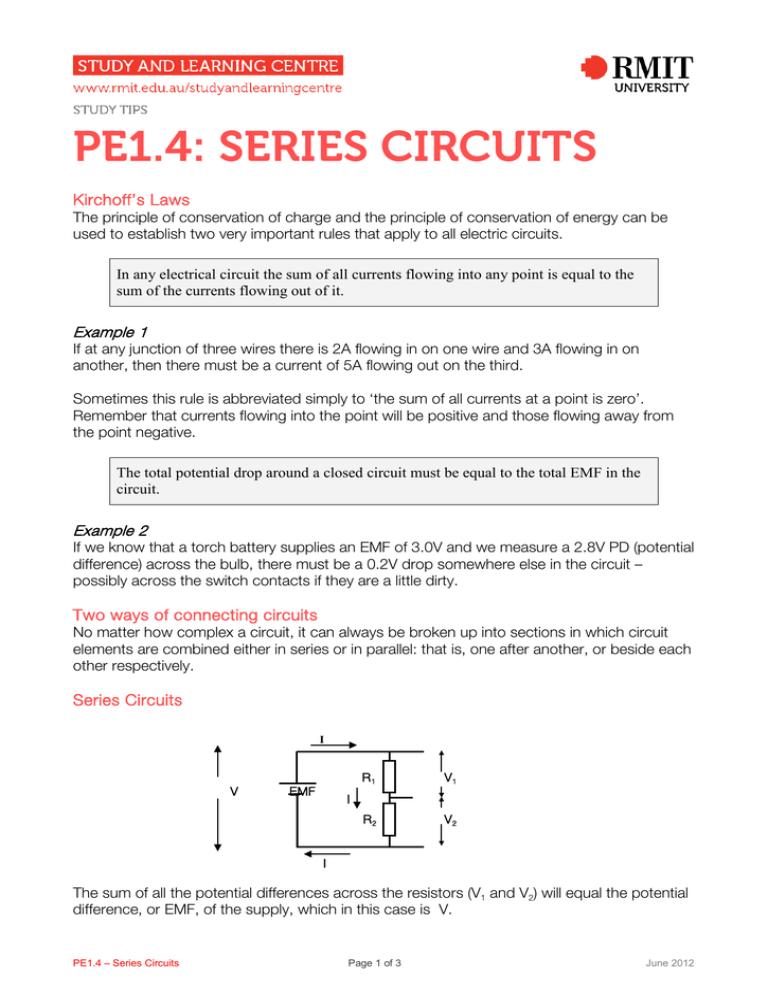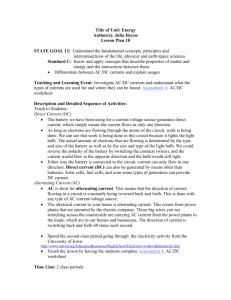PE1.4: SERIES CIRCUITS
advertisement

PE1.4: SERIES CIRCUITS Kirchoff’s Laws The principle of conservation of charge and the principle of conservation of energy can be used to establish two very important rules that apply to all electric circuits. In any electrical circuit the sum of all currents flowing into any point is equal to the sum of the currents flowing out of it. Example 1 If at any junction of three wires there is 2A flowing in on one wire and 3A flowing in on another, then there must be a current of 5A flowing out on the third. Sometimes this rule is abbreviated simply to ‘the sum of all currents at a point is zero’. Remember that currents flowing into the point will be positive and those flowing away from the point negative. The total potential drop around a closed circuit must be equal to the total EMF in the circuit. Example 2 If we know that a torch battery supplies an EMF of 3.0V and we measure a 2.8V PD (potential difference) across the bulb, there must be a 0.2V drop somewhere else in the circuit – possibly across the switch contacts if they are a little dirty. Two ways of connecting circuits No matter how complex a circuit, it can always be broken up into sections in which circuit elements are combined either in series or in parallel: that is, one after another, or beside each other respectively. Series Circuits I V EMF R1 V1 R2 V2 I I The sum of all the potential differences across the resistors (V1 and V2) will equal the potential difference, or EMF, of the supply, which in this case is V. PE1.4 – Series Circuits Page 1 of 3 June 2012 The EMF of the battery is therefore given by EMF = V = V1+ V2 For resistors in series the equivalent resistance is equal to the sum of the individual resistances, or: REQ = R1 + R2 Where REQ is one resistance equivalent to the sum of R1 and R2. Given that the current I leaving the battery must flow through both R1 and R2, then the current flowing in a series circuit must always be the same, or: For resistors connected in series the same current must pass through each resistor. Example 3 Two pieces of nichrome wire (as used in heater elements) have resistances of 10Ω and 20Ω. (a) What current would flow through them, and what power will be produced in them, if they are separately connected to a 12V battery? (b) If they are connected in series what is their total resistance? (c) When placed in series across the 12V battery, what current will flow through them and what power will be produced? Solution (a) The current will be given by I=V/R, so for the two wires separately the currents will be 12/10 = 1.2A, and 12/20 = 0.6A. The power is found from P=V/I and so will be 12/1.2 = 14.4W and 12/0.6 = 7.2W. (b) When connected in series the total resistance will be 10 + 20 = 30Ω (c) The current that flows from the 12V battery will be I=V/R = 12/30 = 0.4A. The total power will be V/I = 12/0.4 = 30W. PE1.4 – Series Circuits Page 2 of 3 June 2012 Exercise 1. Emily has found a point in her car where four wires are attached together. She finds currents of +2.5A and +1.0A in two of the wires, and -4.2A in a third (‘+’ means current into the point and ‘–‘ means current out of the point). What is the current in the fourth wire? 2. Two torch bulbs are placed in series with each other and a 4.5V battery. The current through one is found to be 0.25A and voltage across it is 2.1V. (a) What is the current through the other bulb? Give your answer in mA. (b) What is the voltage across the other bulb? 3. Bill has bought two 12V headlamps for his truck but finds that it has a 24V battery. He decides that the simplest way to overcome the problem is to wire them in series. (a) Will the headlamps work correctly? (b) Do you see any problems with this scheme? 4. Two equal resistors are placed in series and found to have a combined resistance of 34Ω. What is the resistance of each one? 5. A 10V power supply is used across two separate resistors. The current through one is found to be 0.4A, and through the other 0.5A. When they are combined in series, what current (in mA) will flow through them and what is their effective resistance? 6. A 400Ω resistor and a 100Ω resistor are placed in series across a battery with an EMF of 5V. (a) How much current will flow from the battery? Give your answer in mA. (b) What will be the voltage across each resistor? Answers Exercise 1. +0.7V 2. (a) 250mA (b) 2.4V 3. (a) yes (b) yes. If one of the headlamps blows, then the other one will turn off as they are both in series. 4. 17Ω 5. 220mA, 45Ω 6. 10mA, 4V and 1V. PE1.4 – Series Circuits Page 3 of 3 June 2012






